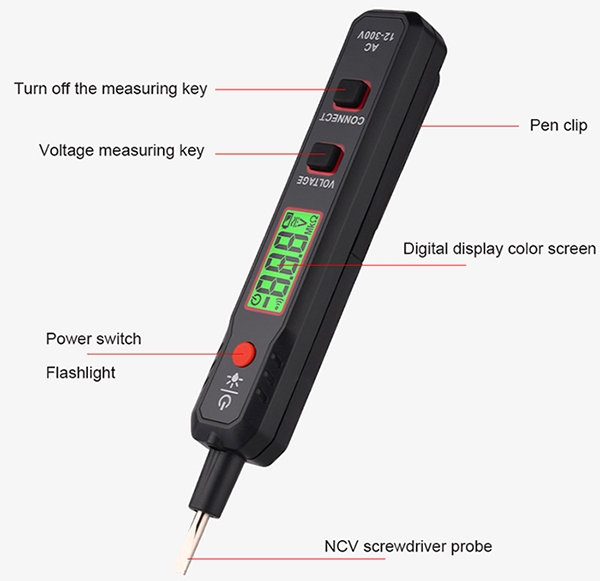SISCO AC voltage detector is a contact voltage tester. The contact circuit tester can act as an emergency flashlight that can illuminate the working area, and it is small and compact, which can be easily inserted into the shirt pocket, and easy to carry.

The contact AC voltage tester design with a LED flashlight lighting
- LED flashlights enhance visibility in dark or low-light environments, making it easier to see the voltage tester's readings or indicators.
- Using an LED flashlight helps accurately locate wires, outlets, or switches, ensuring the voltage tester’s probes are properly aligned with the test points.
- Adequate lighting speeds up the process and makes testing more efficient in dimly lit environments.

Compact size, easy to carry and use
- A compact voltage detector is easy to handle and maneuver, allowing for quick and convenient testing in tight or hard-to-reach spaces.
- Being lightweight and portable, the voltage tester can be carried to various job sites or locations, making it ideal for both professional electricians and DIY enthusiasts.
- A lightweight and compact design reduces hand and wrist strain during prolonged use, enhancing user comfort and efficiency.
Dimension

Applications
SISCO voltage testers are essential tools used in electrical work to determine the presence and level of electrical voltage in circuits and devices. They help ensure safety by allowing electricians and DIY enthusiasts to verify that circuits are de-energized before performing maintenance or installations. Common applications include residential and commercial electrical work, industrial settings, automotive industry, telecommunications, HVAC systems, utilities and power distribution, and renewable energy systems, where they check outlets, wiring, machinery, vehicle electrical systems, communication equipment, HVAC units, power lines, and renewable energy installations for proper voltage and functionality.

Automotive Industry

Telecommunications

HVAC Systems

Commercial Electrical Work
| Model | SISCO-VT-HT89 |
| Measuring Voltage | AC 12-300V |
| Display | LCD display |
| Alarm Mode | Audible alarm |
| Probe Shape | Wide shape |
| Backlight | Red and green backlight |
| Fire Line Identification | According to LCD display "HI" |
| Signal Strength Display | LCD display |
| Signal Strength Indicator | Sound from slow to fast, backlight from green to red, LCD data from small to large |
| Battery Low Power Prompt | No button operation, no induction signal, automatic shutdown after 3 minutes |
| Flashlight | √ |
| Power Supply | √ |
| Safety Level | EN61010-12-030, EN61326-1, CAT Ⅱ 1000V |
| Dimensions | 147*23*26mm |
| Weight | 100g |
Detail

Q1: What is a voltage tester?
A1: A voltage tester is a tool used to determine the presence and level of electrical voltage in a circuit or device. It helps to ensure safety by allowing users to verify if circuits are live (energized) or de-energized before performing electrical work.
Q2: What are the types of voltage testers?
A2: There are various types of voltage testers, including:
- Non-Contact Voltage Testers (NCVT): Detect voltage by sensing the electric field around a live conductor without making physical contact with it. They usually indicate the presence of voltage through a light, sound, or vibration.
- Contact Voltage Testers: Require direct contact with the conductor to measure voltage. They typically have probes or leads that need to touch the wires or terminals being tested.
- Analog Voltage Testers: Use a needle gauge to show voltage levels. These are less common today but still used in some applications.
Q3: What is the importance of the sampling rate in an AWG?
A3: If your voltage tester isn't detecting voltage, check the following:
- Battery: Replace it if it’s dead.
- Settings: Ensure it’s set to the correct mode and range.
- Tester Condition: Test it on a known live circuit to verify if it’s working.
- Use: Make sure you’re using it correctly and making good contact.
- Power: Verify that the circuit is actually live and turned on.
Tips: Can a voltage tester be used in wet or damp conditions?
Using a voltage tester in wet or damp conditions can be risky and generally should be avoided unless the tester is specifically designed for such environments. Here are key considerations:
- Safety: Water and moisture can increase the risk of electric shock. Many voltage testers are not rated for use in wet or damp conditions, so using them in such environments can be dangerous.
- Tester Rating: If you must use a voltage tester in wet conditions, ensure it is rated for such environments. Some testers are designed with higher safety ratings and IP (Ingress Protection) ratings that indicate resistance to moisture and dust. Check the manufacturer's specifications for any environmental ratings.
- Use Proper Equipment: For wet or damp conditions, consider using tools that are specifically rated for such environments. This often includes tools with reinforced insulation and weather-resistant features.
- Dry Conditions: Whenever possible, ensure that the area and the tester are dry before using the tool. If the environment is wet, use a non-contact voltage tester designed for wet conditions, and take all necessary precautions to minimize the risk of electrical hazards.
- Protective Gear: Always wear appropriate personal protective equipment (PPE), such as insulated gloves and boots, when working in damp or wet conditions.
Thank you for buying industrial test and measurement equipment on SISCO.com, all products sold by SISCO and the partner cover a 12 months warranty, effective from the date of receiving the products.
What is covered?
SISCO is responsible for providing free spare parts, and free technical support to assist the customer to repair the defective products until the problem is solved.
What is not covered?
- Product purchased from anyone other than a SISCO store or a SISCO authorized reseller.
- Expendable parts.
- Routine cleaning or normal cosmetic and mechanical wear.
- Damage from misuse, abuse or neglect.
- Damage from use of parts other than SISCO approved.
- Damage from use outside the product’s usage or storage parameters.
- Damage from use of parts not sold by SISCO.
- Damage from modification or incorporation into other products.
- Damage from repair or replacement of warranted parts by a service provider other than a SISCO authorized service provider.
- Damage caused by the application environment not meeting the product usage requirements and the failure to perform preventive maintenance.

